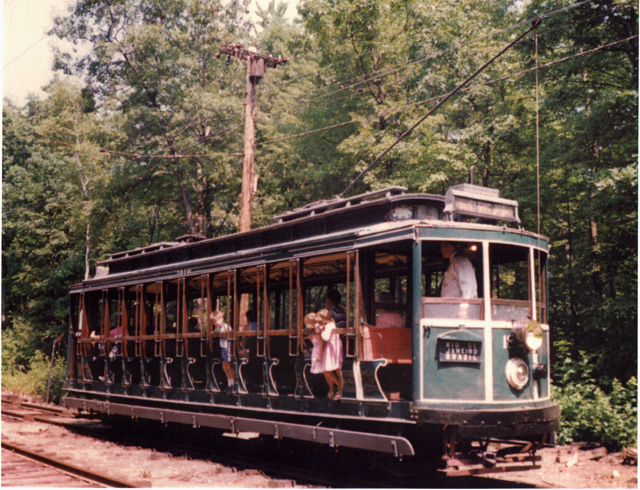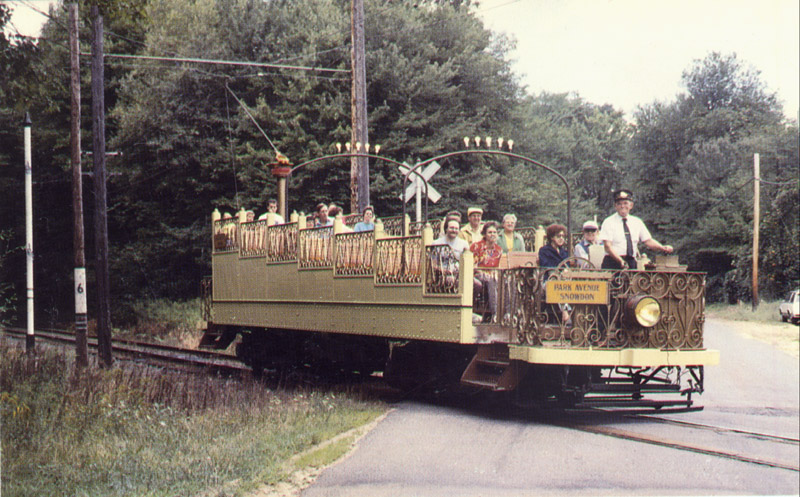
Hear old-time whistles blow and brass bells ring, as an antique streetcar carries you on a three-mile round trip ride through Connecticut countryside. Settle into a closed heated car, and admire its handsome mahogany woodwork and vintage ad cards. An educational narrative is provided while you travel down the tracks. So heed the conductor's call from the Trolley Era of long ago and "Board This Car!" Treat yourself and family to a good time at the Connecticut Trolley Museum in East Windsor, Connecticut. The Connecticut Trolley Museum is owned and operated by Connecticut Electric Railway Association, Inc. Founded in October 1940, it is the nation's oldest incorporated organization dedicated to the preservation of streetcars and the Trolley Era. As a non-profit institution, its educational and historical aim is the establishment of a full size operating street, and interurban railroad system, with appropriate accessory equipment and buildings, to recreate an important phase of New England's business and social life, from 1890 to 1945.

Open to the public from April through December, visitors to the Museum will be fascinated by the 50 pieces of rolling stock. (Pictured above) Montreal Tramways Closed Safety Car 2600. Built in Canada, all steel "lightweight" car running at the Museum. Approximately half are housed within five storage barns. The collection consists of passenger and freight trolly cars, interurban cars, electric and steam locomotives, freight and passenger cars, cranes and service cars. The trolleys at the museum consist of: historic open air cars from Montreal, Rio de Janeiro and American cities. Closed cars from Hartford, Springfield, Boston, New Orleans, New York City, as well as many other cars from the Northeast and throughout the country.(photo below) The St. Louis Car 1850, in the Museum Active Fleet. It was built in 1912 by the St. Louis Car Company. It is a 13 bench open car, once used in Brazil. Also on exhibit are: Express, maintenance cars, and locomotives, along with hartford's historic Isle of Safety, a 15 x 55-foot, Mediterranean-style shelter with terra cotta tile roof, that served trolley patrons.
The Museums' Locomotives include: 1894 G.E. Electric Locomotive, Rare 1910 Climax Steam Locomotive, Vintage New Haven Railroad Coach, Box Cars, Cabooses and other historic equipment. And for the serious Trolley Car Buffs, study the many artifacts on display at the Museum, such as: mechanical and electric equipment, signal systems, ancillary equipment, signal systems, ancillary equipment, maps and documents, car card advertisements, invoices and receipts, bills of lading and hundreds of other items from the Trolley Era.

all major buildings and the Museum's center of operations, are located on a 17 acre facility adjacent to State Route 140 in East Windsor, Connecticut. The right of way used is a 3.2 mile portion of what was originally the Warehouse Point to Rockville branch of the Hartford and Springfield Street Railway Co. Void of all track, the property was purchased when the organization was formed in 1940. Over the years the volunteers have been able to not only build the track, and the overhead power distribution, but all the storage barns, the power substation and a restoration shop.(Pictured below) in the Active Fleet, Montreal Tramways Open Observation Car 4, was built in 1924. During its operation in Montreal it carried tourists passengers for a 25 cent guided tour.

Many people have forgotten the impact trolleys had in the growth of New England. They allowed cities to expand, communities to grow, and the people to broaden their horizons. The Trolley Museum for the education and pleasure of present and future generations.Even though the first successful urban electric street railway was completed in 1887 Virginia, by inventor Frank Julian Sprague of Milford; Connecticut had it's first electrical street railway in 1885. located in Derby, the street railway was unsuccessful because of design flaws. By 1901, streetcar service had expanded, and small communities like East Windsor boasted of having their own line, which allowed them easy access to Hartford and Springfield, Massachusetts. Model T's were still just an idea in Henry Ford's mind, as streetcars delivered people to work, church, shopping, and amusement parks. By 1913, the growth of the trolley era had peaked, and within Connecticut alone there was an incredible 1,118 miles of track, and 2,436 trolley cars in service.
The trolleys represented advanced technology. Eventually, it was the continuing advancement of technology which replaced the trolley's ribbons of steel, with the rubber tire of automobiles. In July 1941 Hartford's last streetcar rolled back to the "barn." Springfield's service ended in June of 1940. By 1948, with only 101 cars remaining in use, streetcar service in Connecticut ceased completely.
[Home]
[Norman Rockwell]
[Rockwell Self Portrait]
[Sturbridge Village]
[Sturbridge Colonial Farming]
[Dickinson Homestead]
[Dickinson Portrait]
[Springfield Armory]
[Stanley Park]
[The Titanic]
[The Titanic Historical Museum]
[Maude Tait]
[Dr.Seuss]
[Dr.Seuss Page]